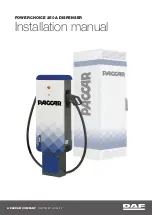
Power terminals overheated, check wiring, including the wiring type and type of strands, and/or fasten bolts if possible.
This error will auto-reset.
Error 28 - Power stage issue
This error will not auto-reset.
Disconnect all wires, and then reconnect all wires. If the error persists the charger is probably faulty.
Note that this error was introduced in v1.36. So when doing an update, it might look like the firmware update caused this issue;
but it doesn't. The solar charger was then already not performing 100% before the update; updating to v1.36 or later merely made
the issue more visible. The unit needs to be replaced.
Error 33 - PV over-voltage
This error will auto-reset after PV-voltage has dropped to safe limit.
This error is an indication that the PV-array configuration with regard to open-circuit voltage is critical for this charger. Check
configuration, and if required, re-organise panels.
Error 34 - PV over-current
The current from the solar-panel array has exceeded the maximum allowed current.
This error could be generated due to an internal system fault.
Disconnect the charger from all power-sources, wait 3 minutes, and power-up again. If the error persists the controller is probably
faulty, contact your dealer.
Error 38 and/or 39 - PV Input shutdown
To protect the battery from over-charging the PV input is shorted.
Possible reasons for this error to occur:
• The Battery voltage (12/24/48V) is set, or auto-detected, incorrectly. Use VictronConnect to disable auto-detect and set the
Battery Voltage to a fixed voltage.
• There is another device connected to the battery, which is configured to a higher voltage. For example a MultiPlus, configured
to equalise at 17 Volts, while in the MPPT this is not configured.
• The battery is disconnected using a manual switch. Ideally the charger should be switched off before disconnecting the battery,
this avoids a voltage overshoot on the charger output. If necessary the voltage trip-level for the PV Short protection can be
increased by raising the Equalization voltage set-point (note: equalization does not have to be enabled in this case).
• The battery is disconnected using a Lithium charge relay connected to the “allow-to-charge” output of a BMS. Consider wiring
this signal to the Remote terminal of the charger instead. This shuts down the charger gracefully without creating a voltage
overshoot.
Error recovery:
• Error 38: First disconnect the solar panels and disconnect the battery. Wait for 3 minutes, then reconnect the battery first and
next the panels.
• Error 39: The charger will automatically resume operation once the battery voltage drops below its maximum voltage setting
(normally Equalisation or Absorption voltages), for 250V versions or float voltage for the other units. It can also takes a minute
to reset the fault.
If the error persists the charge controller is probably faulty.
Error 40 - PV Input failed to shutdown
If the charger is unable to turn off the PV input, it will go into a safe mode in order to protect the battery from over-charging or
having a high voltage on the battery terminals. In order to do that, the charger will stop charging and disconnect its own output.
The charger will become faulty.
Information 65 - Communication warning
Communication with one of the paralleled chargers was lost. To clear the warning, switch the charger off and back on.
Information 66 - Incompatible device
The charger is being paralleled to another charger that has different settings and/or a different charge algorithm. Make sure all
settings are the same and update firmware on all chargers to the latest version.
Error 67 - BMS Connection lost
The charger is configured to be controlled by a BMS, but it does not receive any control messages from a BMS. The charger
stopped charging, as a safety precaution.
This error only shows when there is solar power available and thus the charger is ready to initiate charging. It does not show at
night. In case there is a permanent problem, the error will raise in the morning and clear at night, and so forth.
MPPT solar charger manual
Page 65
Appendix


































